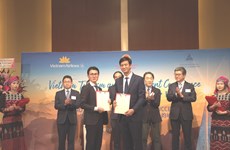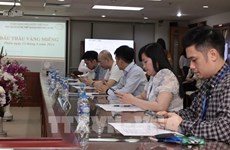HCM City urged to change export structure
Authorities in HCM City are targeting an annual export growth
rate of 17 percent under a programme that also aims to shift the
structure of the city's exports.
Authorities in HCM City are targeting an annual export growth
rate of 17 percent under a programme that also aims to shift the
structure of the city's exports.
The programme also targets raising the city's export turnover (excluding crude oil) to 100 billion USD a year by 2015, the Thoi bao Tai chinh Vietnam (Vietnam Financial Times) reports.
A focus on service sector exports under the programme aims to have turnover from export services accounting for 60 percent of the city's total export value, and competitive products such as garments and textiles, footwear and processed seafood are expected to make up 35 percent of all exports by 2015.
The programme is also set to help accelerate human resource training and to make products with advanced technology contents become key exports of the city by 2020.
Huynh Khanh Hiep, deputy director of the municipal Department of Industry and Trade, said local exporters had been hit during the past years by the global economic downturn and domestic inflationary pressure.
Material import price hikes, tighter monetary policies and high lending interest rates significantly affected the city's current export growth, said Hiep.
"In order for the city to reach the goal of high and sustainable export development in the coming months, it's necessary that it has appropriate direction for development and practical measures to rapidly shift the export structure in line with its advantages," Hiep said.
Vo Thanh Thu from the Vietnam Chamber of Commerce and Industry's international commerce policies consulting board said the city's export value represented as much as 40 per cent of the nation's total figure five years ago, but has tended to decline during recent years.
Thu said the city also needs to focus on high-value exports. She said exports from the city and from Vietnam in general are largely based on the exploitation of labour and natural resources, such as garments and textiles, rice, rubber and coffee. Meanwhile, exports such as milk and electronic devices rely too heavily on imported materials.
Many key industries are focusing on the processing of products, a weakness reflected in 90 percent of the footwear industry's production activities being outwork, said Thu.
Many industries have achieved large export revenues but failed to build their own brand names.
Meanwhile, Thu said, technical barriers and sanitary and safety standards imposed by importing countries were becoming increasingly complicated.
"If the city doesn't pay proper attention [to the problems] and make some changes, the ratio will continue to fall and export efficiency will remain low," she warned, adding that the matter was especially important in the context that the domestic economy depended largely on exports.
HCM City Hi-tech Park Development Centre director Le Phan Hoang Chau said the park will focus on production of semi-conductors and machinery.
He said 60 percent of the value of hi-tech products are now made up by foreign suppliers, while domestic providers were able to contribute only about 5 percent to the value with packing, maintenance and installation work for these products.
Chau urged authorities to speed up localisation of hi-tech products while developing more support industries.
He suggested measures such as developing support industry markets, building databases of domestic support products and facilitating solutions which help innovate technology, develop human resources and manage quality with preferential infrastructure and financing policies.
"The value of export products can't be raised with undeveloped support industries," said Tran Du Lich, a member of the National Assembly.
He urged the city to attach special importance to developing these industries while ensuring clear export strategies to serve the national economy and the country's key southern economic region.-VNA
The programme also targets raising the city's export turnover (excluding crude oil) to 100 billion USD a year by 2015, the Thoi bao Tai chinh Vietnam (Vietnam Financial Times) reports.
A focus on service sector exports under the programme aims to have turnover from export services accounting for 60 percent of the city's total export value, and competitive products such as garments and textiles, footwear and processed seafood are expected to make up 35 percent of all exports by 2015.
The programme is also set to help accelerate human resource training and to make products with advanced technology contents become key exports of the city by 2020.
Huynh Khanh Hiep, deputy director of the municipal Department of Industry and Trade, said local exporters had been hit during the past years by the global economic downturn and domestic inflationary pressure.
Material import price hikes, tighter monetary policies and high lending interest rates significantly affected the city's current export growth, said Hiep.
"In order for the city to reach the goal of high and sustainable export development in the coming months, it's necessary that it has appropriate direction for development and practical measures to rapidly shift the export structure in line with its advantages," Hiep said.
Vo Thanh Thu from the Vietnam Chamber of Commerce and Industry's international commerce policies consulting board said the city's export value represented as much as 40 per cent of the nation's total figure five years ago, but has tended to decline during recent years.
Thu said the city also needs to focus on high-value exports. She said exports from the city and from Vietnam in general are largely based on the exploitation of labour and natural resources, such as garments and textiles, rice, rubber and coffee. Meanwhile, exports such as milk and electronic devices rely too heavily on imported materials.
Many key industries are focusing on the processing of products, a weakness reflected in 90 percent of the footwear industry's production activities being outwork, said Thu.
Many industries have achieved large export revenues but failed to build their own brand names.
Meanwhile, Thu said, technical barriers and sanitary and safety standards imposed by importing countries were becoming increasingly complicated.
"If the city doesn't pay proper attention [to the problems] and make some changes, the ratio will continue to fall and export efficiency will remain low," she warned, adding that the matter was especially important in the context that the domestic economy depended largely on exports.
HCM City Hi-tech Park Development Centre director Le Phan Hoang Chau said the park will focus on production of semi-conductors and machinery.
He said 60 percent of the value of hi-tech products are now made up by foreign suppliers, while domestic providers were able to contribute only about 5 percent to the value with packing, maintenance and installation work for these products.
Chau urged authorities to speed up localisation of hi-tech products while developing more support industries.
He suggested measures such as developing support industry markets, building databases of domestic support products and facilitating solutions which help innovate technology, develop human resources and manage quality with preferential infrastructure and financing policies.
"The value of export products can't be raised with undeveloped support industries," said Tran Du Lich, a member of the National Assembly.
He urged the city to attach special importance to developing these industries while ensuring clear export strategies to serve the national economy and the country's key southern economic region.-VNA













